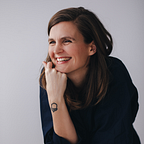Deep Observing
Qualitative Observing to Learn Early in the Design Process
Qualitative observing practiced early on and throughout a design process can bring an unexpected depth to understanding your potential user’s desires. Teams often rely on their personal experience, intuition, or assumptions when testing product ideas—observing before listening adds an extra dimension to your research and the insights that’ll inform the following concept phase.
Listening with Compassion
You might have heard about Deep Listening. Deep Listening is the process of compassionate listening to understand. It requires you to be present in the conversation and stay with the speaker. It is a form of quieting the mind to fully take in what you hear. We often confuse hearing with listening. Hearing is the automatic brain response to sound, and listening requires motivation and effort. The ear hears, the brain listens, and the body senses vibrations.
Deep Listening finds its roots in Buddhism and is also used in psychotherapy and neuroscience. It requires the suspension of judgment and the willingness to receive new information, even if it’s unpleasant. With this, you enhance your capacity to listen with compassion as its essence. This approach creates a safe space in which the speaker can freely, without judgment or expectations, examine and articulate what is present.
The key to deepening your listening is to become aware of drifting off into your thoughts. These thoughts can inform you about what question to ask, but they can also take you somewhere else entirely. So, one part is the practice where you temporarily suspend asking questions and embrace silence to minimize your influence on the speaker and deepen your compassion. The other part is to hear, listen and sense attentively because the body speaks too.
Observation is the bridge between sensing and listening. When we are deepening our listening, we should deepen our observing too.
Observe Your Observing
Observation is gathering information through the senses, both conscious and unconscious. Observing is done best when the mind is neither bound by the brain nor limited by interaction with the environment.
Understanding the difference when you shift from looking (directing your eyes at something) to seeing (something your eyes see) to watching (pay attention for a period of time) to observing can bring an extra layer of meaning and understanding to your research. But let’s take it even a step further.
Understanding the nature of the problem
A big misunderstanding that we often make is the difference between observations and insights. Observations are the building blocks of insights, but they are just facts. Unless we know the why behind an observation, we can’t move on to create a helpful insight. A process is needed to synthesize the observation into insight. Adding the motivation and the desired outcome that hides behind what you have observed will build the proper understanding required for creating a solid insight. And in between, it is essential to catch our presumptions, assumptions, and beliefs that might cloud our observations and turn them into inferences. If we don’t understand the nature of the problem, we can’t create a solid solution.
So what is the difference between observations, inferences, and insights?
Observation The action or process of carefully observing something or someone to gain information.
Inference Using prior knowledge or opinions to draw conclusions.
Insights Revelations that open your eyes to a new way of seeing.
As a former gallery owner and having worked with numerous artists, I like to share a perspective on this topic from an artistic point of view that I am hoping might shed some light on this:
See What Might Not Be Seen
Observing is an essential skill in the art world. This practice requires you to attend to visual contexts more closely than ordinary ‘looking’ requires. When you learn to observe closely, you will start to see things that otherwise might be missed. One perspective artists take when observing is to create awareness around the way you think something looks and draw what you are actually seeing. Training yourself to see what others are missing is a powerful practice when innovating.
When observing in an early product development stage, design thinking stage, or even a pre-conceptual stage, it is vital to create awareness around the layer you personally add to what you see to avoid presumptions. Being aware of your lens can be the key to deflecting the creation of products and services that exclude people or harm the collective and individual well-being. Strengthening awareness sparks the innovation of inclusive, deeply human-centered design.
Drawing from Life
Some artists draw from direct observation; or drawing from life. When observing your audience, you are also drawing from life. When an artist draws a subject by observing it in real life instead of using a photograph as a reference, he can gain more subtle information about the situation. In the traditional sense, artists did their best to recreate their subject matter as realistically possible. Using direct observation sheds light on unexpected things that impact the subject or user that you might miss from a distance.
Observation With a Clear Mind
The critical thing to mention here is; the observation that we are talking about in Design Thinking is the observation with your five senses, but without the mind, without your thinking or personal lenses. Sometimes we think we are making an observation when we are actually making an inference. Your life experiences, background, and knowledge often color your perspective on which we build assumptions that can cloud the observation. That cloud is when observation becomes an inference.
Observation Rendering
The rendering of the gathered information (everything collected through your qualitative research) is where the interpretation of the insights lies. This moment of rendering is where the artist uses their authentic style and creates something new. It is the moment where a unique perspective is welcome to develop innovative solutions to complex questions. It is the moment where unique insights are born. Qualitative insights are the heart of innovation.
